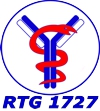MD TP47: Identification of T cell receptor sequences of high-frequent T cell clones in skin lesions and germinal centers in experimental epidermolysis bullosa acquisita
EBA is a typical example of a chronic autoimmune disease. It is characterized by the production of autoantibodies against type VII collagen (COL7), a protein in the dermal- epidermal junction. The autoantibodies bind to the DEJ and induce an inflammatory dermal blistering. The first step of the pathogenicity is the loss of tolerance of CD4+ T cells against COL7. Previous studies have demonstrated that the interaction between antigen-specific T cells and B cells, cytokines produced by autoreactive T cells, and the function of regulatory T cells are related to the pathogenesis of EBA. Thus, T cells clearly contribute to the pathogenesis of EBA, however the antigen specificity of T cells driving the skin disease is ill defined, and a broad characterization of the T-cell receptor (TCR) repertoire in skin lesions is still lacking. Two domains of the non-collagenous region of COL7 have been identified as crucial for the interaction between keratinocytes and the basal lamina and both are currently used to induce EBA in mice: the mCOL7c domain and the VWFA2 domain. TCR analyses have become a helpful tool to identify the antigen-specificity of T cells and can be used to differentiate between skin T-cell infiltrates, for example malignant from benign inflammatory dermatoses.
The Kalies Lab identified TCRb clonotypes in skin lesion of SJL mice, in which EBA was induced by injection of mCOL7-GST in Titermax. An unexpected broad diversity of TCR clonotypes was found in skin lesions and germinal centers. One reason for this high diversity could be the presence of the 26kDa large Schistosoma-derived GST-Tag that is required for stabilization and purification of the recombinantly produced peptide mCOL7c.
In this project I aim to analyze the TCR clonotypes in the skin and germinal centers with the use the second domain of COL7 for induction of EBA in C57BL/6s mice: the VWFA2 domain. My hypothesis is that the diversity of accumulating TCR clonotypes in skin lesions and germinal centers decreases for two reasons: (i) The lack of the GST-tag and (ii) the number of autoreactive precursor T cells specific for VWFA2 should be very low due to the deletion of autoreactive T cell clones during negative selection process in the thymus.

- Projects
- Projects
- Associated projects
- MD projects
- Associated MD projects
- Concluded projects
- Concluded TP
- Concluded Ass.TP
- Concluded MD TP
- MD TP1 - Ig Glycolysation
- MD TP2 - Immunoprivilege
- MD TP3 - ANA antibodies
- MD TP4 - Autoantibody prevalence
- MD TP5 - Treatment of EBA
- MD TP6 - Autoantibody-induced tissue injury
- MD TP7 - Neutrophil signalling
- MD TP7b - IgG-IC-induced signalling
- MD TP8 - The role of IL-33 and its receptor ST2
- MD TP9 - Detection of antigen-specific B cells
- MD TP9b - Detection of antigen-specific B cells in BP
- MD TP10 - Old drugs to block T cells
- MD TP10b - Combination of T cell inhibitory compounds
- MD TP10c - T cell inhibitory compounds (in vivo)
- MD TP11 - Identification of "genetic biomarkers"
- MD TP12 - Combinations of B cell modulatory compounds
- MD TP13 - TREM1 in cutaneous inflammation
- MD TP14 - Signaling in PV
- MD TP15 - Autoantibodies in relatives
- MD TP16 - Drug-induced pemphigoid
- MD TP17 - Keratinocyte lipid mediators
- MD TP18 - Neutrophils + IL-17A-Inhibition
- MD TP19 - C5aR-Inhibition
- MD TP20 - IgG-Subclasses
- MD TP21 - NF-kB in EBA
- MD TP22 - Biochip Mosaics in AIBD
- MD TP23 - Diagnostic Techniques on AIBD
- MD TP24 - Anti-stimulatory effects on Neutrophil-signaling
- MD TP25 - Phage library on systemic scleroderma
- MD TP26 - New EBA-scoring sytem
- MD TP27 - Neutrophil signaling-pathway inhibition
- MD TP28 - Inhibition of Keratinocytes
- MD TP29 - Monoclonal antibodies in EBA
- MD TP30 - Enhancing vaccinations under Immunosuppression
- MD TP31 - Non-desmoglein autoantibodies in PV
- MD TP32 - Neutrophil adhesion
- MD TP33 - MicroRNA-21 in BP
- MD TP34 - PI3K-subunits in EBA
- MD TP35 - Signaling cascade inhibition in EBA
- MD TP36 - Signaling cascades in keratinocytes
- MD TP37 - AT1R-antibodies
- MD TP38 - Cell migration regulation
- MD TP39 - mACh-Receptors in systemic sclerosis
- MD TP40 - Hair and EBA
- MD TP41 - CMV-specific T cells
- MD TP42 - Necroptosis in GPA
- MD TP43 - Neutrophils and NETs
- MD TP44 - Mitochondrial genome in AIBD
- MD TP45 - Target antigens in pemphgoid diseases
- MD TP46 - Alpha-adrenoceptors in Raynaud´s phenomenon
- MD TP47 - T cell-receptor-sequences in autoimmune skin diseases
- MD TP48 - Epitope specificity and glycolization
- MD TP49 - Inhibition of keratinocyte-dissociation
- MD TP50 - Transcriptome profile of endothelial cells induced by autoantibodies targeting AT1R/ETAR in systemic sclerosis
- MD TP52 - Expression of B4GALT1 and ST6GAL1 ....
- MD TP54 - Reactivity of serum antibodies ....
- MD TP55 - Identification of potential therapeutics .....
- MD TP56 - Validation of the inhibition of different signalling pathways ...
- MD TP57 - Inhibition of IFN-γ as therapy for epidermolysis bullosa acquisita
- MD TP58 - Characterization of immunoglobulin G subclass distribution ...
- MD TP59 - Development of an experimental pemphigus vulgaris model in adult mice
- MD TP60 - Interactions between GPCR and anti-GPCR IgG autoantibodies...
- MD TP61 - Glycosyltransferases B4GALT1 and ST6GAL1 in...
- MD TP62 - Sensitivity of diagnostic test systems in dermatitis herpetiformis Duhring
- Concluded Ass. MD TP






